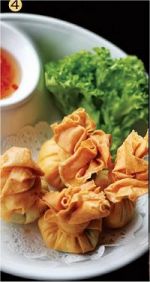 |
A Culinary Journey through Thailand
It's a challenge to describe Thai cuisine in few words, because it is the very history of a people. Sometimes mild, sometimes spicy, it represents the harmonious marriage of centuries-old influences from India (spices and curries) and China (soy sauce, noodle dishes and poultry).
It's a cuisine of the people, obvious as soon as you see the floating markets, long boats gliding along the "klongs," or canals, filled with fruits and vegetables. On one side, you'll see a merchant selling kuay tiao naam, a soup so thick it is served with chopsticks; on the other, fish fritters that are handed to you on a banana leaf. In the bustling streets of Bangkok, there are countless street vendors from dawn to dusk, since Thais eat at any time of the day. Each one has a distinctive yell to promote his merchandise. Only the ice seller has no need to shout, since his cart is fitted out with glass bells. The noodle vendor is the most impressive, his arrival announced by the tok tok tok of his wooden bat on a bamboo tube.

Thai cuisine is, however, first represented by the dishes of the kings and emperors of Siam, who raised its sophistication to the level of art, seeking a balance between sour, bitter and hot.
To briefly describe the ingredients that make up Thai cooking, we must first mention rice and coconut milk. Herbs and spices are omnipresent: lemon grass, galanga, garlic, ginger, mint, basil and coriander. Chilies were introduced into Thai cooking in the late 17th century by Portuguese missionaries who had come to appreciate all their nuances in South America. But here too, it is a question of balance. Thais do not serve two spicy dishes together, but rather one mild and one hot.
The dishes are all served at the table at the same time, and diners help themselves. No dish is more important than another. The accent is on the equilibrium of flavors, textures and colors. Each guest creates his own combination of flavors. It's your turn to discover them!
When it comes to beverages, you can try Thai beer (singha, kloster) and local whisky (mekong). But be sure to drink only bottled water ("namkwat").

Photo below: ID 46064756 / pinkomelet / MSCOMM
Chicken and coconut spiced soup called Tom Kha Gai

-

 Recipes
Recipes
-

 Products
Products
-

 Entertaining
Entertaining
-

 Chefs
Chefs
-

 Hints & Tips
Hints & Tips
-

 Glossaries
Glossaries








